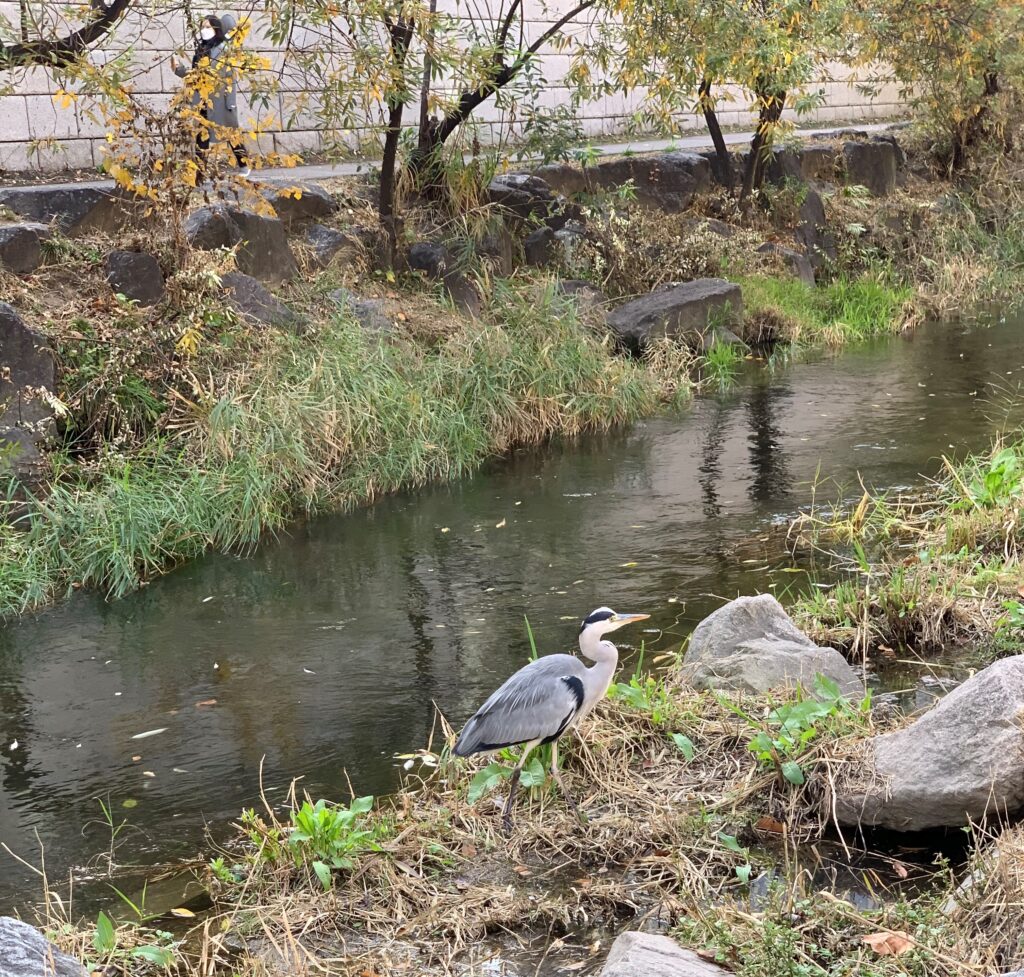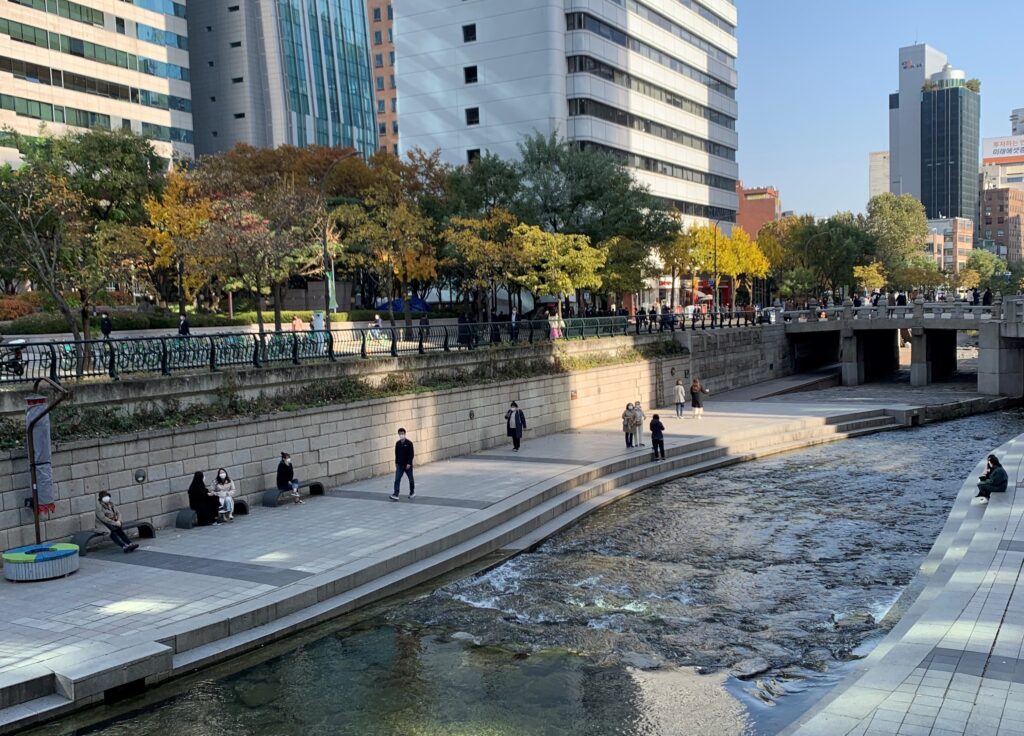From Concrete to Oasis: The Cheonggyecheon and the Future of Urban Stream Restoration
Jiyoon Kim | May 16, 2023

It was a crisp late autumn day in 2021 along the Cheonggyecheon, a stream that flows through the heart of Seoul, South Korea. I visited the stream around 1 p.m., a typical lunch time for downtown office workers. Although the weather was a bit chilly, around 50 degrees Fahrenheit, many people were enjoying the fresh air and serene sounds of the stream. Ever since the Cheonggyecheon was restored in 2005, it has been an enjoyable and safe place for residents and workers to connect with nature. At no time was this opportunity to interact with nature and safely with other people more important than during my visit, the height of the COVID-19 Pandemic, when mask mandates and social distancing were heavily enforced. The Cheonggyecheon provided a much needed respite from the city and the chaos of this difficult time.
In addition to its important role as a public open space in the midst of a city of nearly 10 million people, the Cheonggyecheon provides a number of critical ecosystem services, including many life-sustaining benefits we receive from the nature such as clean air, clean water, and flood control. The stream provides protection from 200-year flood events, has reduced the urban heat island effect along the stream by lowering summertime temperatures by 3.6 degrees Celsius compared to the surrounding environment, helped to reduce air pollution caused by small-particles by 34% and increased biodiversity in the city. The stream provides habitat for many species of flora and fauna, including willow trees, silver grass, heron, mallard ducks, and carp, which can be easily seen throughout the stream corridor.

Today the Cheonggyecheon is considered one of the world’s great urban streams for its critical social and ecological functions. But it wasn’t always this type of asset. The story of its restoration may have important lessons for those who envision restoration of other streams in large cities.
The Cheonggyecheon’s History
The Cheonggyecheon has been an integral part of Seoul’s 600-year history, providing critical access to water for early residents. But it was not until the early 1900s, when the city became highly urbanized, that problems began to arise near the stream. As population density increased, people with few housing options began building an informal settlement along the stream that was considered by many to be an unsightly shanty town. This settlement also posed dangers to public health and safety due to flooding, fire and sanitation. In the 1950s, the Korean Government began to see the Cheonggyecheon neighborhood in the center of Seoul as an area in need of modernization to clean up the unsightly and dangerous conditions. They initiated an extensive process of housing removal, concrete channelization of the stream to control flooding, and overpass highway construction to facilitate automobile movement into and out of the city. In the process, many citizens who were living along the stream were displaced to the remote and undeveloped parts of Seoul. This pattern of urban renewal and the displacement that resulted, was common in cities throughout the world in the middle part of the 20th century.
In the 1990s, the Cheonggyecheon experienced further challenges. The highways constructed in the 1960s were deteriorating due to age and their construction over an unstable stream bed. The city was suffering from intense air pollution, and safety concerns arose from declining neighborhoods around the stream. Community members and merchants began to talk of the need for change, and the possibilities of restoring the Cheonggyecheon as an important asset. In the early 2000s, symposia and public hearings were held with non-governmental organizations (NGOs) and a citizen committee. Notable NGO groups involved included the Citizen’s Coalition for Economic Justice, Green Korea United, and People’s Solidarity for Participatory Democracy. The Dong-A Daily News was an official sponsor of a second symposium held in 2002. They became an important catalyst in the revitalization of the stream and the neighborhood.
Construction began in 2003. The overpass highway was removed, and the stream was uncovered. Some of the soft bottoms were restored and some remained. Natural water circulation to the stream was disrupted due to urban development, so the project team needed to figure out a solution to restore its hydrologic function. The Landscape Architect, Hyun-Don Shin, of Seo-Ahn RnD Landscape Design Group, shared that the city collaborated with the Korea Water Resources Corporation to supply water from the nearby Han River. The restored stream was opened to the public in 2005.
Stream Operation
An urban stream like the Cheonggyecheon requires a complex maintenance and operations plan in order to maintain its ecological function and protect the public. I was able to get a glimpse of how the stream is maintained from an interview with Jeongeun Lee from the Cheonggyecheon facility management team. Ms. Lee described the most challenging aspect of the stream maintenance as securing the safety of the people who use the stream area during the rainy season. Floodgates open automatically during rains and the water level can rise quickly, creating the potential for people to be trapped in the stream bed.

Ms. Lee believes that to improve the safe operation of the stream, there should be fundamental structural changes in how stormwater and wastewater flow into the Cheonggyecheon. Currently, the city uses a combined sewer overflow system, where wastewater can enter the stream during periods of heavy rainfall. This poses environmental and public safety concerns. This system should be reconfigured to separate wastewater from stormwater flow, however this change is prohibitively expensive at present.
Maintaining a healthy stream environment requires working with the local community and businesses to raise awareness, according to Ms. Lee. One effort to educate the public involved the establishment of the Cheonggyecheon School of Ecology. The school has programs throughout the year engaging the public to learn more about the stream. Examples of programs include a class on Spring flowers, tours of the migratory birds protection area, tours of the flora and fauna throughout the changing seasons, and programs that promote fishing along the stream.
The Cheonggyecheon Museum offers additional educational activities to raise awareness of the stream and its history. The museum includes a series of dioramas that depict how people have used the stream in the past and how the landscape has changed. Preserving the site’s heritage was an important priority in the design. Gwangtong Bridge, dating back to the 15th Century, was restored as an effort to celebrate this heritage. To this day, the city of Seoul is working to resolve issues and controversies over restoring remaining historical infrastructure, such as building a Cheonggye Sewerage History Hall.

Lessons for Urban Stream Restoration
The restoration of the Cheonggyecheon was a success in mitigating pollution, increasing biodiversity, providing badly needed open space for the community, and revitalizing this area of Downtown Seoul. However, there have been issues with the displacement of residents and businesses located along the stream at the time of restoration, and operational challenges to ensure safety of the public during the rainy season continue to be a challenge.
The Cheonggyecheon restoration offers a peek at a hopeful future of restored urban streams around the world. At the same time, it teaches us valuable lessons for challenges that come with complex restoration, and help with more streamlined and sustainable restoration projects. As I have personally experienced a joy of easily accessible natural landscape in the middle of the mega city, I was able to see at first hand how it was benefiting both humans and nature. There are a number of key lessons to be learned from this example.
First, urban stream restorations must design to meet multiple objectives and the needs of different interest groups. While many projects focus primarily on flood control and open space, this project included ecological function and heritage preservation.
Second, the focus on stream processes is key. Maintaining hydrologic function requires constant operation and maintenance. These functions and the operation of the system must be integrated into the design and long-term management plan of the project.
Finally, engagement of the community is vital to the success of the project. The opportunities and resources presented by the Cheonggyecheon School of Ecology and the Cheonggyecheon Museum are key to building and sustaining support for restoration efforts.

Jiyoon Kim is a graduate of the Master of Landscape Architecture program at California State Polytechnic University, Pomona (2023). She holds a Bachelor of Science degree in Ecology and Evolutionary Biology from the University of California, Los Angeles. Born and raised in highly urbanized Seoul, South Korea, her background in Ecology led to her interest in urban ecological design, habitat restoration, and Landscape Architecture.